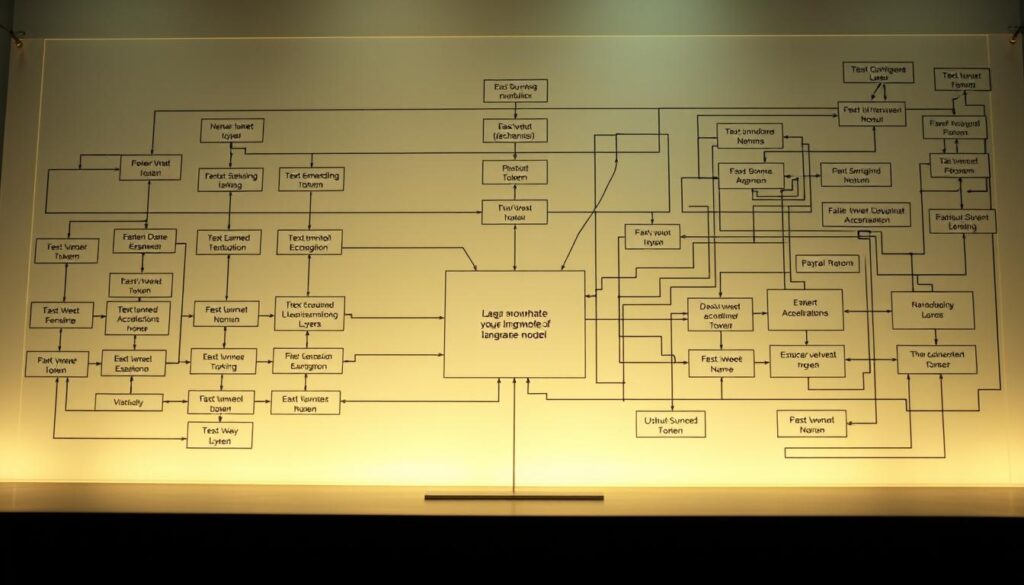Have you thought about how artificial intelligence is changing our daily lives? Picture using a computer that understands you and talks back just like a person. This is not just something that might happen in the future. It’s happening right now. The rise of AI has taken our communication and productivity to new levels.
This guide will teach you about the workings of LLMs and their big role in many fields. It doesn’t matter if you’re a pro, just curious, or trying to keep up with tech. Knowing about LLMs in AI is key to making the most of them in your life and job. You will learn that these models are more than tools. They are changing the game, changing how we use technology.
Key Takeaways
- Large Language Models (LLMs) revolutionize communication between humans and machines.
- Modern LLMs appeared in 2017, using transformer models to improve how computers understand us.
- Famous LLMs include OpenAI’s ChatGPT and Google’s BERT, which are used in many ways.
- LLMs can do routine tasks for us, saving companies lots of time.
- It’s important to understand LLMs to use their power well in different fields.
The Evolution of LLMs in AI
Language models have been part of AI’s growth for over a century. Their development helps us understand and create human language better. Each new breakthrough brings us closer to models that grasp context well, making communication easier.
Historical Context of Natural Language Processing
Natural Language Processing (NLP) started with Ferdinand de Saussure’s work from 1906 to 1912. After World War II, the need for global communication made NLP more important. The 1950s saw tech advancements, like the Georgetown-IBM translation experiment, shaping the future of language models.
In 1883, Michel Bréal brought semantics into the picture, stressing language’s meaning. This idea is key in today’s language model algorithms.
Key Milestones in AI Development
AI’s growth has several landmark moments. Arthur Samuel’s work in the 1950s laid the base for machine learning. Then, Frank Rosenblatt’s Mark 1 Perceptron mixed neural networks and machine learning.
The intro of transformer architecture in 2017 changed how we handle language tasks. It uses self-attention to process language better. OpenAI’s models, from GPT-1 to GPT-4, show quick progress in AI, highlighting LLMs’ big potential in AI fields.
What is LLM in AI?
Large Language Models (LLMs) are a big step forward in AI. They help machines grasp and produce human language. By learning what LLM means, we see how complex and technological they are. These models use deep learning to handle lots of text, making responses that sound like a human.
Definition and Mechanism of LLMs
LLM means programs that analyze and create text using deep learning. They are trained on billions of text pieces to predict words correctly. The key to these models is the transformer architecture from Google in 2017. Because of this, LLMs like GPT-3 or GPT-4 can understand complex language patterns well.
The Role of Neural Networks
Neural networks are crucial for LLMs to work. They process info in a way that’s like how our brains work. For LLMs, transformer neural networks help understand the context and links between words. This way, LLMs do great in tasks like summarizing texts, translating, and making content. As they get better, they learn more and become more useful in many areas.

How Do LLMs Work?
Understanding large language models (LLMs) sheds light on what they can do. LLMs start working when they get input, like prompts or questions, from users. These inputs undergo analysis by complex algorithms. These algorithms come from detailed research. Then, LLMs use their training to create relevant and coherent responses.
Understanding the Workflow of LLMs
The LLM workflow includes:
- Input Analysis: Algorithms look at the input to find important features.
- Context Interpretation: LLMs understand word relationships thanks to their training. This helps them get what users want.
- Output Generation: With huge data from AI, LLMs can make quality answers that meet user expectations.
Importance of Algorithms and Datasets
The success of LLMs depends a lot on their training data. They learn from trillions of words. This unsupervised learning helps them get the hang of language details. The more data and better algorithms they get, the sharper and more flexible they become. This makes them useful for many different things.
| Category | Example Applications | LLM Type |
|---|---|---|
| Technology | Search engines, code assistance | Generic language models |
| Healthcare | Understanding proteins, vaccine development | Instruction-tuned models |
| Customer Service | Chatbots and conversational AI | Dialog-tuned models |
| Marketing | Sentiment analysis, campaign ideas | Generic language models |

Training Methods for LLMs
Learning how to train LLMs is key to unlocking their power. Training involves several steps, such as pre-training, fine-tuning, and iterative methods. These steps work together to boost the model’s performance, making it useful in many different situations.
Pre-Training and Its Significance
Pre-training lays the groundwork for LLM training. This stage uses huge amounts of text, sometimes over 1000 GB, to teach the model about language patterns. This vast amount of information helps the model understand how to form coherent responses across various contexts.
Fine-Tuning for Specific Applications
After pre-training, fine-tuning sharpens the model for specific tasks or sectors. This involves using special datasets to make the LLM better at certain jobs. This way, the model gets really good at handling particular challenges, improving the quality of its outputs.
Iterative Refinement Techniques
Iterative methods are about continuously improving the model. By making regular tweaks and updates, these techniques help the LLM adapt to new data and challenges. This constant refining keeps the model performing well and ensures it meets the changing needs of users.

Popular Examples of LLMs
In the world of large language models, some names really stand out. These models have changed how we use technology in various areas. They show us what’s possible, from understanding languages to creating new texts.
OpenAI’s GPT Series
The GPT series from OpenAI has reshaped text generation. GPT-3, with its 175 billion parameters, can do everything from writing text to chatting. Within just two months of its 2022 launch, ChatGPT reached over 100 million users. This shows how popular and efficient it is. We’re now waiting for GPT-4, rumored to be even more powerful, with over 170 trillion parameters.
Google’s BERT and Its Applications
Google’s BERT is amazing at understanding the context. This makes it super useful for finding things online or figuring out what people feel about something. It’s got 342 million parameters, helping machines understand us better. This has made searching online much more accurate.
Text-to-Text Transfer Transformer (T5)
The T5 model is all about versatility. It turns every task into a text-to-text problem. This makes it easier to handle things like translating languages or summarizing texts. It’s been doing great across many language tasks, proving its broad abilities.

| LLM Model | Parameters | Main Features |
|---|---|---|
| OpenAI GPT-3 | 175 billion | Text completion, conversational AI, generative capabilities |
| OpenAI GPT-4 | Rumored 170 trillion | Advanced generative features, improved context handling |
| Google BERT | 342 million | Contextual understanding, sentiment analysis, named entity recognition |
| T5 | Not specified | Unified text-to-text approach, language translation, summarization |
Benefits of Using LLMs in Various Industries
Large Language Models (LLMs) are changing how industries work. They make understanding natural language better. This lets businesses talk to customers in a way that feels more natural. LLMs can be used in many areas, bringing lots of benefits.
Natural Language Understanding
LLMs make talking to machines feel more like talking to people. In customer service, they power chatbots that give fast, right answers. This makes talking to customers smoother and better.
In healthcare, doctors use LLMs to go through lots of medical info fast. This helps them make better choices for their patients.
Automation and Efficiency
LLMs make work faster by automating routine jobs and making content. Salesforce uses LLMs to manage customer relationships better. This makes workers more productive.
In law, firms use LLMs to check contracts and do legal research quickly. This cuts down on manual work. It lets experts spend time on bigger projects.
Improving Accessibility for Users
LLMs make digital tools easier for everyone to use. They help with things like voice control and translating languages on the spot. This opens up tech to more people.
For example, online stores suggest products using text and pictures. This makes shopping better for all customers. It makes digital services available to people no matter their background.

Challenges and Considerations of LLMs
Large language models (LLMs) are changing the world of artificial intelligence. They offer many benefits but also have big challenges. It’s important to deal with these issues to build trust and use the technology right.
Bias and Fairness Issues
The issue of bias in AI is a big challenge for LLMs. The training data might have biases, leading to unfair AI responses. Bias affects how the AI sees and treats different groups of people. We need to work continuously to check and fix the data, making AI fairer for everyone.
Data Privacy and Security Concerns
Data privacy is another big worry. Training LLMs with sensitive info could accidentally reveal private details. Using strong anonymization methods for personal info and following tough security rules can lower these dangers. Companies must focus on protecting user data to keep their trust and follow laws.
Environmental Impact of LLM Training
Training LLMs uses a lot of energy and resources, which affects the environment. As more companies use AI, we also have to think about making it sustainable. Finding more efficient ways to train these models is key, like using methods that need less memory and power.

Applications of LLMs in Real Life
LLMs are changing how we work in many fields, making things faster and better. They help in creating content, aiding customers, and translating languages. This makes businesses more efficient and improves their services.
Content Generation and Summarization
OpenAI’s GPT-4 is a star in making new content. It can whip up everything from stories to articles for specific readers. This is great for marketing and news. Companies like StitchFix use AI to come up with catchy ads, mixing computer smarts with human touch.
LLMs are also masters of making things brief. They can turn long texts into short, easy-to-read summaries. This saves time for both the people writing and the ones reading.
Customer Support Automation
Customer support has gotten a big boost from LLMs. Brands like Walmart and GoDaddy use AI to sort out help requests quickly and accurately. Doordash has a chatbot for delivery questions, making customer chats smoother.
Tools like Grammarly study how words feel to make replies sound just right. This makes customers happier with the help they get.
Language Translation and Multilingual Support
LLMs like NLLB-200 are changing the game in translating languages. They can handle 200 languages, including rare ones. This helps global businesses talk better with everyone, no matter the language.
Systems like the one from Roblox make chatting in many languages easy. This helps people from different places play and talk together.

The Future of LLMs in AI
The world of AI is changing fast, thanks to Large Language Models (LLMs). We’re seeing a future where AI gets even smarter. This means LLMs will have more uses and be able to do more things.
Technological Advancements on the Horizon
LLMs will get better because of new algorithms and their growing abilities. Researchers are working hard to make them more efficient without losing quality. We might see LLMs made just for certain fields like healthcare and law, improving how accurate they are.
Adding predictive AI to LLMs is a big step forward. This lets them give answers that fit the context better and ask smart follow-up questions. This makes them much better at things like helping customers and making new stuff, as seen with platforms like Pecan’s Predictive GenAI.

Potential Societal Impacts
LLMs will change jobs a lot and bring up new ethical questions. By taking over simple tasks, they’ll create new roles in managing and watching over AI. We’ll need people who understand these complex AI systems and can use them responsibly.
It’s also key to have rules for using AI the right way. Setting up these rules will help deal with biases and privacy issues from handling lots of data. As AI becomes more common in different areas, keeping innovation and ethics balanced is crucial.
Everyone’s excited about how LLMs will change things like personal help, customer service, and making content. As these changes happen, it’s important to keep up with what they’ll mean for us all.
How to Get Started with LLMs
Want to dive into LLMs? There are lots of tools and resources to help you start. Knowing the basics of programming and machine learning helps. You’ll find free and paid courses that make learning easier.
Resources for Learning About LLMs
Begin with simple YouTube videos to understand LLM technology. Check out sites like LLM University for all skill levels in Natural Language Processing. While some courses like “Generative AI with Large Language Models” need payment, there are free ones too, like the “Train & Fine-Tune LLMs for Production Course.”
If you prefer learning by doing, try the “Train and Deploy a Real-Time Financial Advisor” course. Join online forums and discussions on Discord and Reddit to learn from others. And don’t forget to subscribe to newsletters like “AI Weekly” for the latest news. Working on your programming skills regularly is key.
Tools and Frameworks for Development
Developing AI? Frameworks like LangChain make it easier to create LLM applications. Beginners can find tutorials from many companies. Techniques like Prompting and Fine-Tuning are vital for improving LLMs, taught in courses such as “Retrieval Augmented Generation for Production with LangChain & LlamaIndex.”

The use of LLMs has grown a lot recently. Starting to use these tools is exciting. Remember, combining practice with theory is essential for success in this fast-growing field. Jump in and explore the possibilities.
Common Myths About LLMs in AI
In the ever-changing world of artificial intelligence, there are many false beliefs about LLMs. These myths can confuse people and create wrong ideas about AI. It’s important to know the truth about what LLMs can and can’t do.
Debunking Misconceptions
Many think that LLMs, like ChatGPT, can look things up online and summarize websites. But, 70% of users falsely believe they have this ability. Also, 80% of uses come from people who think LLMs work like Google, leading to misinformation. As a result, most questions about what LLMs can do are based on misunderstandings.
It’s found that 50% of the time, LLMs give wrong answers or “lies,” showing their limits. Legal experts worry about LLMs making up legal cases, like the made-up case of Mata v. Avianca, Inc. This teaches us to question the information LLMs provide.
Understanding Limitations
Many folks don’t get the key difference between how LLMs learn and how they interact with us. About 40% wrongly think LLMs can remember and bring back past conversations. This misunderstanding shows a gap in knowing how LLMs work. Also, 60% of people worry about LLMs keeping sensitive info, showing widespread concern.
LLMs analyze huge amounts of data to create text based on likely outcomes. Sometimes, they make mistakes or “hallucinate,” which happens in 15% to 20% of what they produce. Though they’re good at making text sound natural, understanding their limits helps us use them better.

Conclusion
LLMs are changing how we work and interact online in big ways. They can sift through huge amounts of text quickly. This lets them grasp complex language patterns and give back relevant answers. We see their power in things like analyzing data on the spot, understanding feelings in text, and even writing code. These skills make them useful in many fields, from healthcare to finance.
To really benefit from LLMs, it’s key to know how they learn. They use advanced methods such as zero-shot and few-shot learning. This helps them adapt to a wide range of tasks easily. When thinking about LLMs, remember the good and the challenges. We must consider ethical concerns, biases, and their environmental cost.
The future of LLMs looks bright. We can look forward to more accurate answers, tailored performance, and fairer AI use. Staying up-to-date with these developments is important. It helps you use LLM technology wisely, making the most of its benefits while being aware of its challenges.









